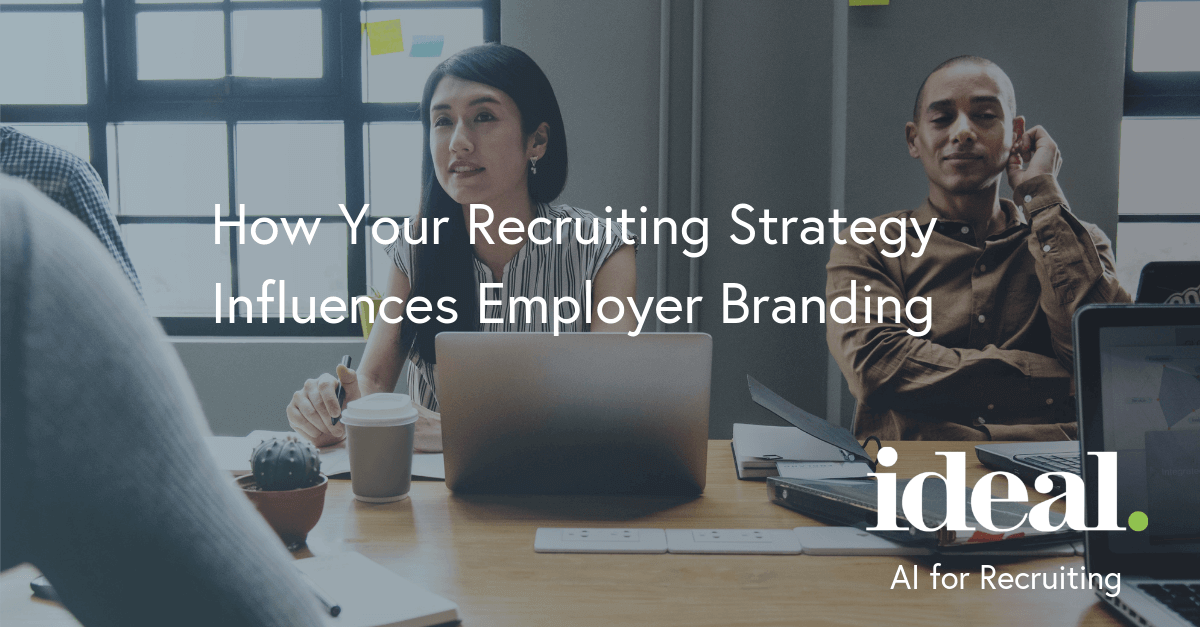Is it really possible for your recruiting strategy to impact your brand?

Employer branding is a vital piece of the hiring puzzle when it comes to organically attracting talent. Because human capital is an organization’s biggest asset, attracting the right kind of talent is a cornerstone to long-term growth, innovation, and overall company health.
Targeted recruiting tactics can tap into pools of talent that best align with an organization’s culture and values. But what happens when the talent you’re trying to recruit doesn’t see you in the same light? Your employer branding can make or break your ability to pick up the right people.
Factoring in candidate experience
It’s easy to get so caught up with hiring goals and sticking to management’s plan that you forget how the other side perceives your organization. A Cornell University study on employee reception found that when employees sensed that HR was more motivated by cost reduction and employee exploitation, rather than wellbeing or service quality, engagement levels dropped. If employees already affiliated with the organization feel a sense of disengagement, the need to woo potential candidates becomes even stronger.
What incentive does someone have to serve an organization that has little consideration back for him or her? As recruiting is often the first point of contact with candidates, building a positive perception of company values and mission must start with talent acquisition strategy.
There are plenty of tell-tale statistics that reveal the holes employers are leaving wide open in their hiring process. Talent Board states that only 27% of employers survey candidates about their experience after they are hired. Additionally, a negative candidate experience caused 46% of candidates to sever a business relationship, meaning that they would not reapply to the same company again. Even organizations that enjoy a strong brand name in industry a have nothing to gain from a subpar candidate experience. The bottom line is: organizations’ treatment of candidates matters.
The messages your recruiting strategy may be giving off
Whether you use automated screening processes or prefer to rely more on the human touch, a recruiting strategy will inevitably send a message to a candidate. What that message tells depends on how the strategy is optimized to deliver a particular candidate experience. What is your hiring process really telling the talent pool?
Too Big and Busy to Care
What’s worse than receiving a generic rejection that starts with “unfortunately?” Not receiving anything at all. Especially for candidates who are further along in the hiring pipeline than others, but ultimately didn’t make the final cut, receiving a concluding message to tie up loose ends gives closure. Bad response rates and ghosting don’t just make an employer look bad, they leave a sour taste that will have a candidate questioning why they would ever waste their time again with the same company.
You’re Just Another Cog in the Machine
What are your application and interview questions like? Remember, you’re hiring individuals with pre-existing values and personalities, not just work that can be shaped to fit any scenario. Even if a candidate seems capable and intelligent, you’re still doing them a disservice by ignoring their fit for the position and company. Think about whether your message says you value each individual or just the company’s bottom line and results.
Too Good to be True
Sugar-coating a situation can also tell a candidate that there’s something they’re not being told. Transparency about a company’s vision, a position’s daily realities, and some of the frustrations, allows people to more thoroughly weigh their options. Challenges are a given in any job, so don’t be hesitant to lay some of them out. High turnover of disillusioned employees will only hurt an organization in the end.
Lack of Organizational Direction
Fragmented communication within HR can lead to multiple managers reaching out to the same candidate, revealing organizational holes that don’t exactly give off the picture of authority. Conflicting information in interviews, vague job descriptions, and constantly changing HR contacts may tell candidates that their onboarding and work experience there won’t be any more organized. Through using automation and technology, talent acquisition can further streamline their process to focus on high-level tasks.
Slow and Creaky Processes
Inflexibility, cookie-cutter procedures, a mile-high hierarchy, and a seemingly never-ending screening process hint at a stale recruiting strategy that’s probably been in place for decades. Adapt your strategies to the current cultural and technological landscape to freshen up the employer brand.
Employer branding isn’t a luxury reserved exclusively for tech companies looking to give off a trendy, value-driven vibe. It should be a foundational part of HR’s talent acquisition strategies. From wording in promotional content to the attitude of recruiting managers, every level of the hiring funnel impacts employer branding and candidate’s perceptions of whether they’d want to work for you.
—
Brett Farmiloe is a co-founder of executive leadership search firm, Y Scouts, based in Arizona, USA. He’s also CEO of a digital marketing agency and contributes a monthly column to Forbes, SHRM, Inc.com, and Huffington Post. Follow Y Scouts on Twitter or LinkedIn.
